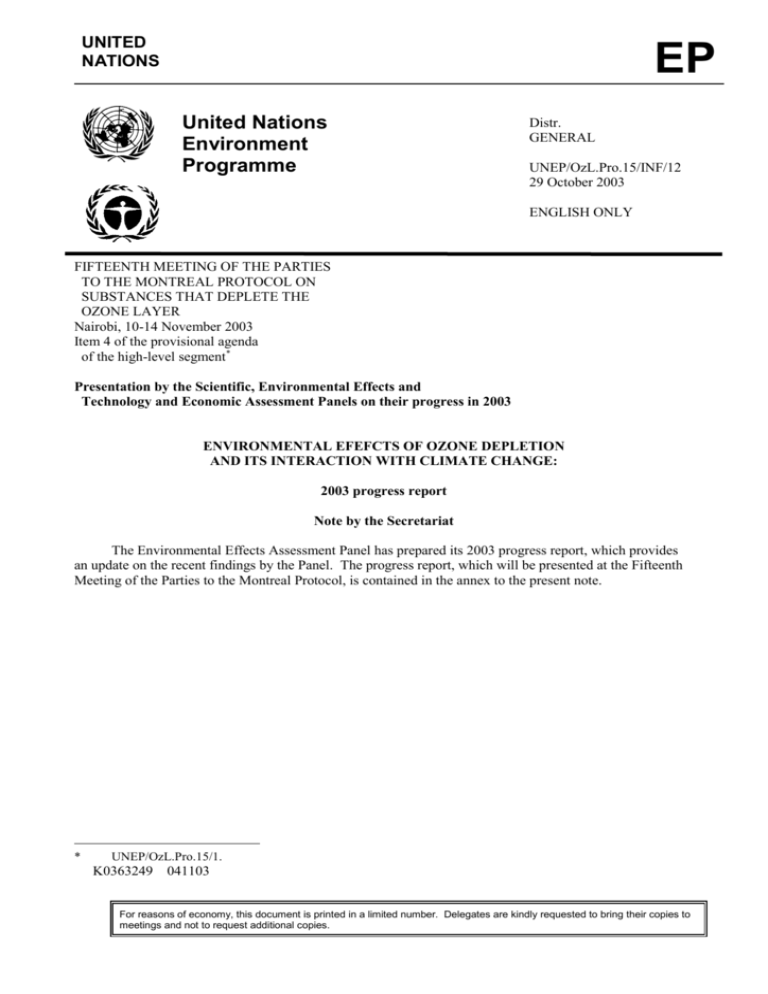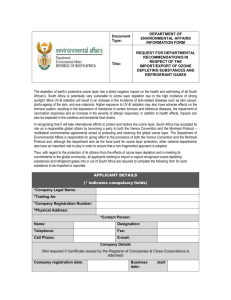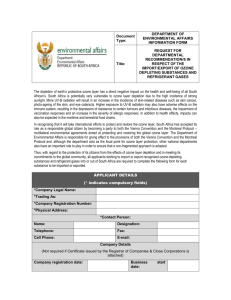Environment - Ozone Secretariat
advertisement

UNITED NATIONS EP United Nations Environment Programme Distr. GENERAL UNEP/OzL.Pro.15/INF/12 29 October 2003 ENGLISH ONLY FIFTEENTH MEETING OF THE PARTIES TO THE MONTREAL PROTOCOL ON SUBSTANCES THAT DEPLETE THE OZONE LAYER Nairobi, 10-14 November 2003 Item 4 of the provisional agenda of the high-level segment* Presentation by the Scientific, Environmental Effects and Technology and Economic Assessment Panels on their progress in 2003 ENVIRONMENTAL EFEFCTS OF OZONE DEPLETION AND ITS INTERACTION WITH CLIMATE CHANGE: 2003 progress report Note by the Secretariat The Environmental Effects Assessment Panel has prepared its 2003 progress report, which provides an update on the recent findings by the Panel. The progress report, which will be presented at the Fifteenth Meeting of the Parties to the Montreal Protocol, is contained in the annex to the present note. * UNEP/OzL.Pro.15/1. K0363249 041103 For reasons of economy, this document is printed in a limited number. Delegates are kindly requested to bring their copies to meetings and not to request additional copies. UNEP/OzL.Pro.15/INF/12 UNITED NATIONS ENVIRONMENT PROGRAMME Environmental effects of ozone depletion and its interactions with climate change 2003 Progress Report The latest full report was the Environmental Effects of Ozone Depletion and its Interactions with Climate Change: 2002 Assessment. This Progress Report is an update on recent findings. Ozone and UV changes The smaller ozone hole in the spring of 2002 should not be interpreted as a sign of early recovery of the ozone layer. The extent of Antarctic ozone depletion varies greatly from year to year depending on meteorological conditions. Satellite data indicate that the ozone hole in 2003 developed rapidly and by early September its area was already close to the previous alltime record, which had been set in year 2000. This is in sharp contrast to the situation in 2002, when the ozone hole was only two thirds of that size. The environmental impacts depend critically on the geographical extent and seasonality of the ozone depletion. Ozone amounts were again low in the Arctic winter of 2002/2003. Evidence for a slowdown in ozone loss in the upper stratosphere since 1997 has been reported. A statistical analysis of satellite-derived ozone profiles indicates that the rate of ozone loss at 35-45 km altitude has diminished globally, and that these changes are consistent with changes in total stratospheric chlorine. This constitutes the first indication of a recovery of ozone at these altitudes. However, these reported changes are for ozone in the upper stratosphere only, and detection of any recovery in the total column ozone, which is most relevant for environmental impacts of UV radiation at the Earth’s surface, would not be expected for several years. The future evolution of ozone remains uncertain, firstly because current chemical models are unable to reproduce accurately all of the observed ozone variability, secondly because the rates of future increases in greenhouse gases are not yet established, and thirdly because interactions between ozone depletion and climate change are not yet fully understood. New estimates of UV radiation extending further back in time are now available at some sites. For example, a method for estimating daily erythemal UV doses using total ozone, sunshine duration, and snow depth has been developed and applied at Sodankyla, Finland, for the period 1950–1999, constituting the longest UV series available to date. 2 UNEP/OzL.Pro.15/INF/12 There has been improved co-ordination between groups involved with ground-based measurements, satellite-derived measurements, and radiative transfer modelling, improving the reliability and usefulness of data. For example, the lower concentrations of summertime tropospheric ozone in the southern hemisphere compared with that in the northern hemisphere led to errors in derived ozone columns from some satellite sensors. The recent availability of measurements of ozone profiles in the southern hemisphere has enabled improvements in algorithms to retrieve ozone data from satellites. Measurements of UV radiation that are more directly relevant to environmental effects (e.g., photochemical and photobiological effects) are now more widely available. Understanding and quantifying the effects of clouds and aerosols on UV radiation have been improved. Further efforts have been made to assess the contributions from the various factors affecting UV measurements through modelling studies. Clouds, and to a lesser extent aerosols, are important modulators of surface UV radiation, which are likely to be affected by climate change. However, an understanding of their future changes, as well as their detailed effect on UV radiation still remains uncertain. There have been further improvements in standardisation of UV information provided to the public. This has been achieved through the publication of international guidelines (UV Index) supported by all of the relevant international agencies. Several countries are now adopting these standards. Health A recent analysis of epidemiological studies has confirmed that UV-B exposure contributes to the development of cortical cataract of the eye. The same analysis concluded that UV-B exposure may contribute to posterior subcapsular cataract. Cataract remains the leading cause of blindness worldwide, and represents an increasing public health burden in both developed and developing countries. High-risk groups for some of the detrimental effects of UV-B radiation, for example immunosuppression, have been identified within the human population by genetic analyses. For skin cancer, important determinants of increased risk include skin type and associated variants of a particular gene (MC1R) related to pigmentation. Risk groups for UV-B induced suppression of immune responses to vaccination have been identified recently on the basis of variation in the gene coding for an immunologically important protein, interleukinThese people can only be identified by genetic analysis, and the increased risk may not be evident when assessing the population as a whole. It was hypothesised several years ago that exposure to UV-B radiation may prevent or reduce the severity of specific auto-immune diseases and several internal cancers, and new reports add to knowledge in this area. These studies are mainly ecological in nature, correlating geography or climate with disease prevalence. For example, increased latitude has been associated with increased prevalence of multiple sclerosis and insulin-dependent diabetes. Recently, a decreased risk of multiple sclerosis was associated with higher sun exposure at ages between 6 and 15 years. The risk of developing prostate cancer was reduced by personal behaviour leading to higher levels of solar exposure. Vitamin D synthesis, induced by UV radiation, is proposed as the key mechanism reducing progression of these diseases. Confirmation in an experimental system is required to validate these hypotheses. 3 UNEP/OzL.Pro.15/INF/12 Additional information confirms that consumption of certain dietary components and supplements may be protective for many of the detrimental health effects associated with UV-B radiation. Dietary components that have shown such effects include green tea and tomato paste; dietary supplements include lutein and antioxidants such as -carotene and other carotenoids, vitamin E and vitamin C. Recent work indicates that mild, transient increases in temperature may stimulate immune responses. The higher temperature associated with climate change may interact with the immunomodulating effects of UV-B radiation. Terrestrial ecosystems A sizeable proportion of the many recent studies on plant and ecosystem response to UV radiation has been conducted in field settings, both with UV-B supplementation from lamps, and by using filters to manipulate present levels of solar UV. Such research allows more realistic assessments of the role of solar UV. New research on gene regulation in response to UV-B has furthered our understanding of the role played by this radiation, allowing us to make broader generalizations and predictions regarding UV-B effects on plants and ecosystems. Recent work supports earlier observations that under field conditions, higher plants, mosses and lichens are generally well protected from significant UV-B damage, since growth and production are seldom affected. However, changes in morphology, UVabsorbing pigments, DNA, and antioxidant levels are frequently reported. Gene activation studies reveal that numerous groups of genes are regulated by UV-B radiation, which may lead to increased DNA repair, synthesis of antioxidants and UV-absorptive pigments. Chemical changes induced by UV-B include UV-screening pigments and other compounds that have diverse functions in plants, such as protection against pathogens and insects. Studies show that the suites of genes activated by UV-B radiation in laboratory conditions are different from those activated in field experiments. This underscores the importance of conducting studies in the field and may help explain the differences in sensitivity exhibited by plants under experimental conditions where UV-B is supplied by lamps together with low background levels of visible radiation as opposed to plants studied in the field with higher visible radiation. Changes in insect feeding preferences on plants in response to UV-B radiation support earlier observations of increased insect deterrence; however, exceptions have been reported. Gene activation studies indicate a distinct overlap in suites of genes activated by UV-B and those stimulated by insect wounding of plants. The altered expression of these genes may lead to increased insect deterrence. An increasing number of studies on microbes have been conducted and many show that microbial communities are generally sensitive to UV-B radiation. When exposed to solar UV on the surface of foliage, soil, litter and peat, fungal and bacterial assemblages often change in species diversity and composition. Changes in proportions of fungal species on litter have been associated with changes in litter decomposition. Altered decomposition rates have important implications for nutrient cycling in ecosystems. Some microbes not exposed to sunlight, such as those associated with plant roots in the soil, appear to respond indirectly to solar UV. Similarly, populations of microarthropods (small invertebrates) living in Antarctic soils decreased with solar UV exposure. 4 UNEP/OzL.Pro.15/INF/12 Aquatic ecosystems Recent research conducted in the field under natural conditions has confirmed results from previous laboratory and mesocosm studies showing that solar UV-B in conjunction with other stress factors can have detrimental effects on primary producers, consumers and decomposers in both freshwater and marine aquatic ecosystems. These studies continue to show that solar UV produces DNA lesions and photooxidative damage in the natural habitat and inhibits biomass productivity and developmental processes. However, they also indicate that many organisms and communities have developed strategies to mitigate detrimental effects of excessive UV. The new field studies indicate that major metabolic and developmental processes require the natural proportion of UV-B, UV-A and visible radiation for optimal performance. Research has been directed toward understanding the genetic basis and molecular mechanisms of UV-induced responses and response to other stress factors (including elevated temperature, desiccation, increased salinity) in primary producers. Hundreds of genes were found to be involved in the early stress responses and the adaptation mechanisms of cyanobacteria, phytoplankton and macroalgae. These genes control previously unknown metabolic processes that regulate carbon uptake and basic cellular pathways. The role of UV-Binduced reactive oxygen species (ROS) in molecular stress mechanisms has previously been underestimated. Climate change can alter responses of primary and secondary consumers to UV radiation through temperature-mediated effects. Future increases in coloured dissolved organic matter (CDOM) related to climate change or other environmental disturbances may subsequently decrease the exposure of zooplankton to UV-B radiation. Multiple factors seem to negatively affect amphibians. These factors include both site specific local effects (such as pesticide deposition, habitat destruction and disease) as well as global effects (such as increased UV-B exposure and global warming). Ecophysiological, paleoecological and genetic studies reaffirm that important components of aquatic ecosystems are sensitive to solar UV. In addition to influencing biomass producers (phytoplankton and macroalgae), primary and secondary consumers and decomposers (bacteria, viruses and other heterotrophic microorganisms), UV affects alga-bacterium and virusphytoplankton interactions. Although not fully understood, synergistic and antagonistic effects continue to be noted between climate change and the role of UV in aquatic ecosystems. Biogeochemical cycles Enhanced UV-B radiation can reduce emissions of methane and carbon dioxide from northern peatland microcosms. UV-B results in a reduction in gross photosynthesis, net ecosystem CO2 exchange, and methane emissions from the microcosms. Morphological changes in plant structure can partly explain the reductions in methane emissions. Satellite imagery has provided a first view of the global distribution of coloured dissolved organic materials (CDOM) that control the penetration of UV-B radiation into the sea and are an important source of sulfur and carbon emissions. UV-induced photoreactions of CDOM and changes in ocean circulation patterns, such as those related to the 1997-1998 El Niño event, strongly influence CDOM distributions. 5 UNEP/OzL.Pro.15/INF/12 Models and remotely-sensed data have been used to quantify the time scales of interaction between iron deposition and pigment biomass response. As these linkages are most pronounced at mid-to-high latitudes, these studies highlight the regions where UV flux may interact with the generation of global atmospheric iron and its deposition and the oceanic biological response system. Sulfur emissions from the ocean are affected by interactions between UV-B radiation and climate change. Dimethylsulfide (DMS) emissions influence the balance between incoming and outgoing radiation in the marine atmosphere. New studies show that loss of DMS induced by UV-B is an important determinant of its concentrations in the surface ocean. These new observations have been made in the North Atlantic Ocean and the Southern Ocean. The results indicate that the influence of DMS-related atmospheric sulfate particles is modulated by the levels of surface UV radiation UV radiation induces nitrogen oxide (NOx) emissions from terrestrial plants and algae. NOx emissions participate in tropospheric reactions that affect air quality. The UV-induced emissions from plants occur at natural concentrations of NOx and they are possibly linked to plant metabolism or the conversion of nitrate, analogous to that observed on snow surfaces. Other research indicates that UV exposure stimulates NOx production from aquatic algae. A newly-identified terrestrial source of ozone-depleting chloromethane is strongly enhanced by global warming. New research has shown that chloride methylation by pectin, which is a widespread constituent in plant tissue, is an important source of atmospheric chloromethane (methyl chloride). The strength of this source increases dramatically when temperatures increase. Air Quality Stratospheric ozone recovery is calculated to yield more tropospheric ozone and increased atmospheric warming in the future. Calculations predict that tropospheric ozone will increase globally by up to 50% by 2100, ignoring impacts on meteorology. This is estimated to increase by a further 10% due to stratospheric ozone recovery. The impact of this increase on climate is difficult to quantify as ozone concentrations are very variable, both in space and time. Models suggest that there has been a significant reduction (up to 30%) in the amount of ozone transported from the stratosphere to the troposphere in the last 30 years. Ozone concentrations in the troposphere have increased due to anthropogenic emissions. Stratospheric ozone depletion has both increased the rate of ozone production in the troposphere due to enhanced UV-B, and reduced the amount of ozone transported from the stratosphere. Current estimates suggest that in total, stratospheric ozone depletion has reduced tropospheric ozone concentrations. The impact of stratospheric ozone depletion on tropospheric OH is probably smaller than previously calculated. Estimates of global OH (the main chemical oxidant in the troposphere) have been made using measurements of atmospheric concentrations of methyl chloroform and an assumed release rate. Recent measurements suggest that methyl chloroform is being released to the atmosphere in quantities much greater than was assumed, and hence that the inferred downward trend for OH in the last decade could be incorrect. 6 UNEP/OzL.Pro.15/INF/12 Risks to humans and the environment from substances (such as trifluoroacetic acid and chlorodifluoroacetic acid) produced by atmospheric degradation of HCFCs and HFCs continue to be judged minimal. Although the amounts of these compounds are expected to continue to increase in the future because of climate change and increased use, recent studies have not identified additional environmental hazards. Materials The accelerating effect of higher ambient temperature resulting in higher rates of solar UV-induced damage to polymers was confirmed and quantitatively analyzed. A field exposure study on polyethylene and polycarbonate polymers estimated the increased detrimental effects of solar UV wavelengths at higher ambient temperatures. While the results are applicable to specific locations only, the finding could help in assessing the impact of global warming on solar UV degradation of polymers. Studies on the stability of novel formulations of common polymers exposed to solar UV-B show the role of fillers and additives in enhancing the photodamage process. Some conventional fillers such as calcium carbonate and novel nano-structured inorganic fillers recently available, both contribute to enhanced UV susceptibility of filled polypropylenes. Mixtures of available light stabilizers act synergistically in photostabilization of polyolefins. Recent data also confirm the synergistic effects of conventional light stabilizers used in combination with the hindered amine light stabilizers [HALS] in photostabilizing common polylefin plastics. Recent studies on the solar UV damage to polymer-based coatings provide details of the degradation process and help identify more effective stabilizers. These studies on industrially important classes of coatings, including polyurethane and acylic coatings, provide an improved understanding of their photodegradation process. Several of the studies also confirm the previously reported damaging effects of temperature and humidity on the photodegradation of coatings. ----- 7







